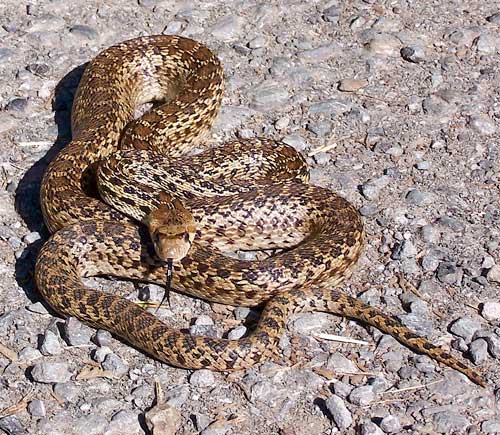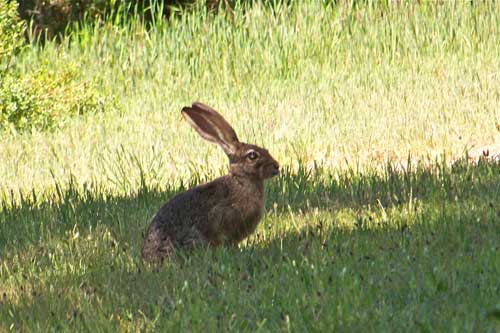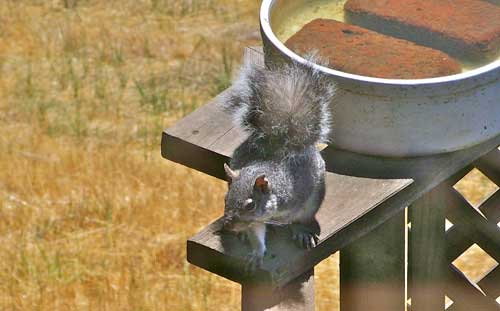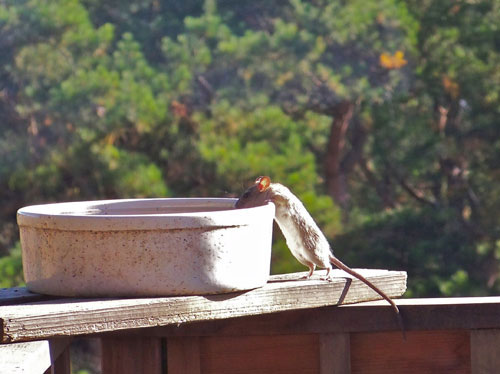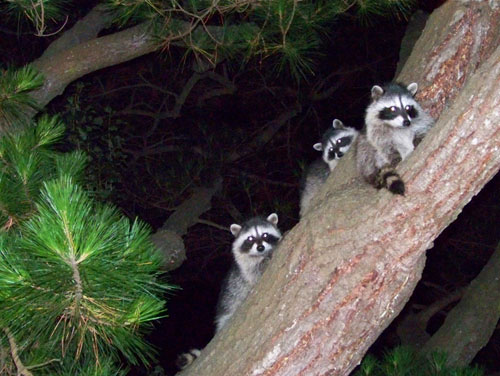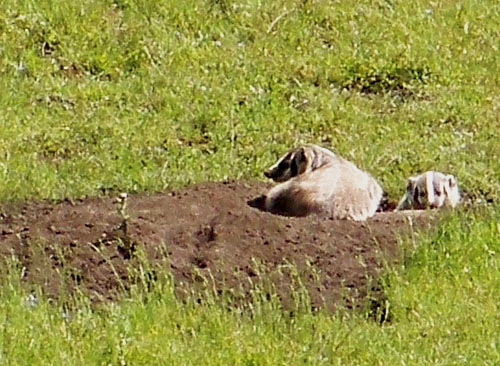 Around the first of the year I sometimes post a roundup of the creatures that have shown up around Mitchell cabin.
Around the first of the year I sometimes post a roundup of the creatures that have shown up around Mitchell cabin.
This year I’m doing it again, starting with a butterfly and dragonfly followed by a variety of larger critters.
This exhibit ends with a coyote, a bobcat, two badgers, and two deer rubbing noses.
Regular readers of this blog will recognize some of these photos from past postings.
Here a buckeye butterfly rests on a chrysanthemum that’s growing in a flowerpot on the deck. ___________________________________________________________________

A dragonfly pauses on the twig of a tree that’s next to the deck. Dragonflies can easily be distinguished from damselflies because when they are at rest they leave their wings extended while damselflies close their wings over their bodies when at rest. __________________________________________________________________
 A Pacific tree frog on a bamboo shoot near our hot tub.
A Pacific tree frog on a bamboo shoot near our hot tub.
Some people call them Pacific chorus frogs. During the winter, their main mating season, males make their way to water and then charm females to the water with a chorus of chirping.
________________________________________________________________

Gopher snakes are not poisonous, but they mimic rattlesnakes, coiling up and wagging their tongues when threatened. This one was near the foot of our driveway.

A jackrabbit in the field outside our kitchen window pauses to look around .

This is the only chipmunk I’ve ever seen around Mitchell cabin. I’m just glad I had my camera nearby when it showed up.

A Western gray squirrel basks in the sun after taking a drink from our birdbath.

A roof rat takes a drink from the birdbath. These rats originated in southern Asia, and you’ll recall it was their fleas that spread the Black Death throughout Europe in the 14th Century, killing roughly half the people.

This cute possum used to be a regular nighttime visitor, but so many raccoons have been hanging around the cabin in the evening that we seldom see any possums these days.

Three raccoons in a tree beside Mitchell cabin. ______________________________________________________________
 A gray fox enjoys the sun on our deck.
A gray fox enjoys the sun on our deck.
_________________________________________________________________

A coyote watches me park my car as I arrive back home.

A bobcat hunts outside our kitchen window.

A mother badger and her kit eye the world from their sett, as badger dens are called.

Two deer touch noses as a herd of six blacktails graze downhill from Mitchell cabin.
For reasons of space, no birds are included in this posting. Look for a gallery of our fine feathered friends in a week or two.
Tags: badgers, blacktail deer, bobcat, Buckeye butterfly, chipmunk, coyote, damselfly, dragonfly, gopher snake, gray fox, jackrabbit, Pacific tree frog, possum, raccoons, racoons, roof rat, Western gray squirrel
From a butterfly to a pair of badgers, from a newt and a salamander to a bobcat and a coyote, this posting is a collection of some of my favorites from among the photos I’ve taken of wildlife around Mitchell cabin.

A Buckeye butterfly atop a chrysanthemum on my deck.

Closeup of an amphibian, an arboreal salamander.

Lying low, another amphibian.
A Pacific tree frog’s color depends on where it is at the moment. Unlike chameleons, whose colors change to match background colors, tree frogs’ colors change (between brown and green) depending on how dry or moist their surroundings are.

A poisonous amphibian.
The skin of a California newt such as this secretes a neurotoxin, tetrodotoxin, that is hundreds of times more toxic than cyanide.

A macho reptile.
Male Western fence lizards do pushups to intimidate other males. In the process they reveal their blue undersides, which is why they’re sometimes called Blue-bellies.

A colorful but seldom seen reptile.
I found this Pacific ring-necked snake in a rotten log while splitting firewood. The snake eats very small creatures, tadpoles, insects, and especially salamanders. It has just enough venom to immobilize them but is not dangerous to humans.

A beady-eyed garter snake warms itself in the sun on my driveway.
Garter snakes are the most-common genus of reptile in North America. Although they are venomous, their venom is too mild to harm humans. However, when they’re disturbed, garter snakes emit a foul-smelling secretion from a gland near their anus.
Common garter snakes come in innumerable variations and are found in fields, forests and wetlands nationwide. Like this snake, adults average about four feet in length. In West Marin, their diet typically consists of tadpoles, slugs, and earthworms. But unlike other snakes, they don’t eat insects. When first born, the snakes are prey for bullfrogs. Hawks and foxes eat adults.

Gopher snakes are non-venomous although they don’t want you to know it.
“When disturbed, the gopher snake will rise to a striking position, flatten its head into a triangular shape, hiss loudly and shake its tail at the intruder,” the Arizona-Sonora Desert Museum website notes. “These defensive behaviors, along with its body markings, frequently cause the gopher snake to be mistaken for a rattlesnake.”

Golden-crowned sparrow disguised as a stained-glass window.

Heading for a drink at the birdbath on Mitchell cabin’s deck, a crow hops over a second crow, which stays put at their birdseed buffet.

A great blue heron hunting gophers in my field.

Chipmunks visit Mitchell cabin only occasionally, so I felt lucky to snap this photo of one.

A Western gray squirrel as seen from my bedroom window.
Every morning the ground around Mitchell cabin is littered with the freshly cut tips of pine branches because of this squirrel and his clan. Squirrels like to feed on pine trees’ cambium layer, which is immediately under the bark, and in the process they gnaw off twigs.

Trying not to be noticed.
West Marin’s large jackrabbits, which some people call black-tailed hares, are often seen in the late afternoon and evening around Mitchell cabin. To avoid catching the eye of predators, jackrabbits typically sit motionless unless the danger comes too close. Then they suddenly spring away, making sharp, evasive turns as they flee.

A gray fox on Mitchell cabin’s deck.

Young raccoons retreat to a tree when they feel threatened by other animals.

A blacktail doe nurses one of her two fawns.

Relying on its spots for camouflage, a newly born fawn tries to be invisible in tall grass by lying absolutely motionless even though I was leaning over it to take a photo.

A buck and two fawns bounding across tractor-mowed grass.

A mother badger and her cub sun themselves on the mound of dirt around their burrow (known as a “sett”).

A bobcat hunting outside my kitchen window.

A coyote heads for cover in, appropriately enough, a patch of coyote brush.

Besides photographing the wildlife around Mitchell cabin, I also enjoy having a bit of fun with it. My posting about encouraging a bodhisattva possum on her path to spiritual enlightenment has proven to be one of the best-read I’ve ever put online.

I take each species’ disposition into account when determining what it is best suited to learn. Raccoons, as you might guess, are natural bartenders.
 The biggest challenge I’ve faced in training wildlife has been convincing different species to get along with each other.
The biggest challenge I’ve faced in training wildlife has been convincing different species to get along with each other.
I felt a bit like a miracle worker when I finally got a possum, a fox, and a raccoon, none of which traditionally like each other, to dine nose to nose just outside my kitchen door.
I did it by setting out well-separated handfuls of peanuts for them and over time moving the handfuls closer and closer together. Now why can’t diplomats do that in the Middle East?
Tags: arboreal salamander, badgers, blacktail deer, bobcat, Buckeye butterfly, California newt, chipmunk, coyote, crows, garter snake, Golden-crowned sparrow, gopher snake, Great blue heron, grey fox, jackrabbit, Pacific ring-necked snake, Pacific tree frog, possum, raccoons, Western fence lizard, Western gray squirrel
 Around the first of the year I sometimes post a roundup of the creatures that have shown up around Mitchell cabin.
Around the first of the year I sometimes post a roundup of the creatures that have shown up around Mitchell cabin. A Pacific tree frog on a bamboo shoot near our hot tub.
A Pacific tree frog on a bamboo shoot near our hot tub. A gray fox enjoys the sun on our deck.
A gray fox enjoys the sun on our deck.

